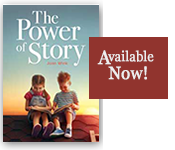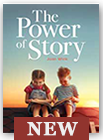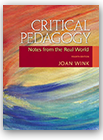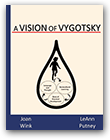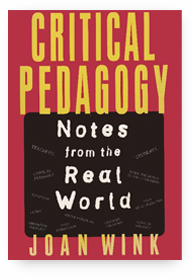Except from:
Wink, J. (2004, 3/e, pp.138-139) Critical Pedagogy: Notes from the REAL WORLD. Boston, MA: Allyn & Bacon.
The archetypal way of doing critical pedagogy is to experience problem posing: to name, to reflect critically, to act – and then begin again. When you have long since lost this book, I hope you will remember one of the greatest legacies of Paulo Freire: problem posing. I have purposely saved this specific example to place here, as a lead-in to the final activity of this chapter, so that you will see that problem posing need not be only a three-step process. If you choose to pose problems in 3, 5, or even 17 steps, it doesn’t matter as long naming, reflecting critically, and acting are inherently a part of the transformative process.
How to Do It
- To name. Form small groups, and ask each person to name (state) a problem in her school site. After each has named a problem (or contradiction, conundrum, sticky situation, or mess), the small group builds consensus and chooses one problem to name.
- To reflect critically. Each small group reflects critically and searches for various approaches to improve the situation.
- To act. The small group lists their recommended action to be taken.
The Experience
This experience took place in Arizona with the same group of teachers as in the previous example. You will recall that they had already read about The Mess (see Figures 6.1 and 6.2) as part of their reading assignment for the activity Comprehending and Comprehension. At this point in our relationship, I think that they knew about problem posing; they knew about The Mess. I think they assumed that problem posing had to be only this prescribed three-step process. I wanted them to see that it could be three steps or four or however they organized it. I also wanted them to know that problem posing is cyclical and can be experienced in multiple ways. More than anything, I wanted them to experience problem posing.
To Name
In this context, the problems that were named were the many mandated tests, lack of youth activities, the media, lack of unity and articulation among local school districts, lack of parental involvement, the high social value placed on monolingualism, a lack of local literacy events, and low teacher salaries.
We listed everything on the large blank pieces of paper taped to the wall. Next, the students read the list and reflected privately with their colleagues. Our challenge was to choose one situation as a whole group to continue the activity. We began by eliminating some of the problems that had been posed. After much discussion, the group chose to focus on literacy within the community, including students, families, and educators.
To Reflect Critically
Next, we began the process of reflecting and naming possible approaches to solutions. I encouraged the teachers to think creatively, and they had just read about “The Mess”, so they knew there were to be no boundaries on our thinking. We were searching for options to improve literacy and increase literacy events throughout the community.
The following possible approaches were listed on large pieces of paper taped to the wall: support local libraries, buy books for schools, create mentoring processes, reach out to senior citizens to encourage their participation in literacy activities, fund a bookmobile, create reading buddies with older and younger students, and create scholarships. Throughout this process, our codes were as simple as filling in the large blank sheets of papers with the students’ thoughts.
To Act
Critical pedagogy calls us to action. Critical pedagogy is good interactive pedagogy, that extends to the real world, to the local community. The teachers knew we were heading for action. Because we had just read about “The Mess”, we chose to follow that action process and make true individual commitment statements, which were then taped to the wall:
I commit to do the following:
- Get more books for my classes.
- Bring in people to read to my class.
- Allow choice for my students reading.
- Bring more family members into my classroom.
- On my birthday and family members’ birthdays, donate books to the local library.
- Take time for reading.
- Bring in scientists to my science classes.
- Clean out my boxes of old comic books and bring them in for the students to read.
- Share my own books with the students in my classes.
- Create fund raising activities.
- Develop an award system in my class to encourage reading.
- Make reading fun in my class.
- Work with the parents of my students on al of the bureaucratic forms they need to know how to complete.
- Provide information for families about what they can do at home with their children to improve their literacy levels.
- Discuss library issues with the staff in my school site.
- Educate myself more about literacy.
What has happened since then? How have those commitment statements become action? As with all transformative actions, it all depends on the teachers and learners who are involved. Just as with the international students who read about Pennycook, I might never know what happens with literacy and the commitment statements in this community in the desert. In the Preface of this book, I likened our work to that of farmers: We plant seeds. How the seeds grow and develop depends on many other factors in the environment. At the time of this writing, I know that these lists of commitments still hang on the walls of this university classroom, the ideas have been sent to a state professional newsletter, and the commitment statements have been published in the local paper for all to see. Freeman and Freeman (1992, 1994, 1998) often write that one of the most effective principles of pedagogy is to have faith in the learners. To be honest, I have complete faith that good things will develop around this group of committed graduate students/teachers.
